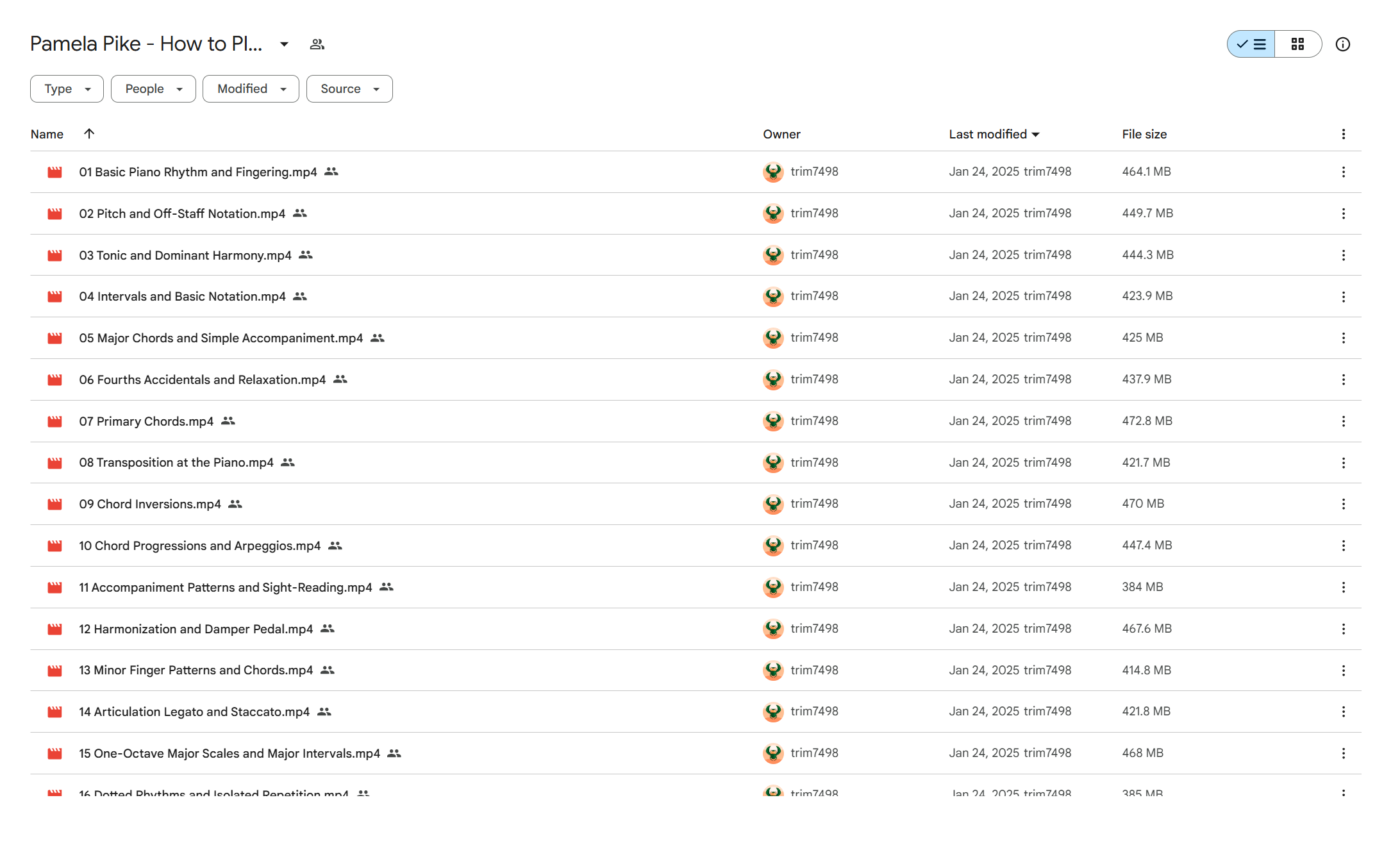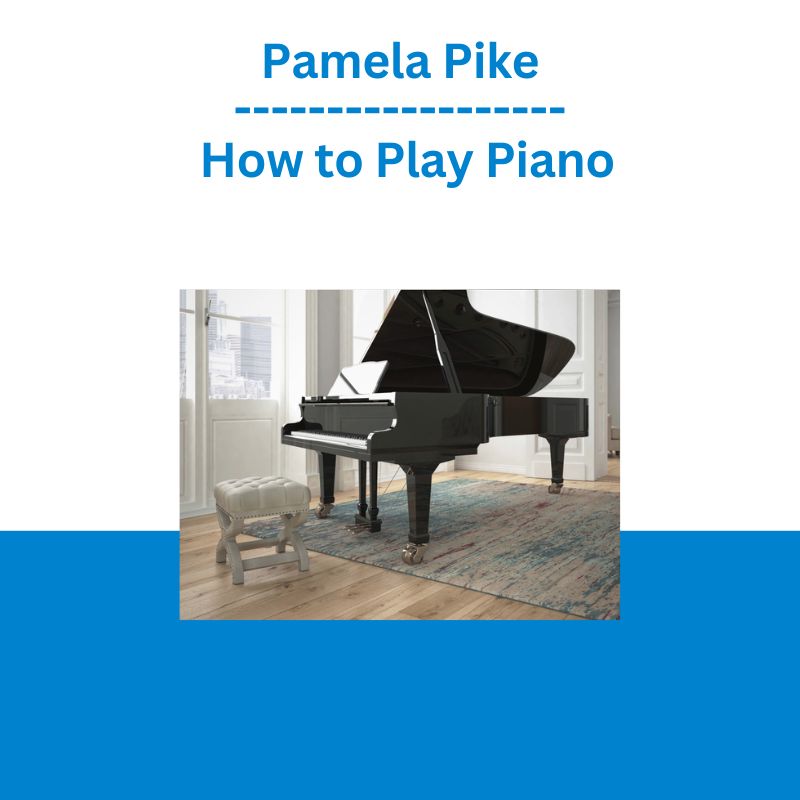*** Proof of Product ***

Exploring the Essential Features of “Pamela Pike – How to Play Piano”
How to Play Piano
Tickle the ivories and awaken your inner Beethoven with lessons from a master piano instructor-no appointment required.
LESSON
Trailer
01:Basic Piano Rhythm and Fingering
Let’s start by playing some music! From minute one of this course, you will be at the piano, fingering keys and playing tunes. In this opening lesson, you’ll familiarize yourself with the piano, perform a few basic exercises to warm up, and explore some introductory rhythm patterns. By the end of the lesson, you’ll know how to play the theme from Beethoven’s Ode to Joy.
34 min
02:Pitch and Off-Staff Notation
After reviewing the introductory finger patterns you learned in the first lesson, delve into the concepts of pitch and meter. Find out about the concept of measures and different types of notes. Then explore the C major five-finger pattern and play it in action with your first étude.
31 min
03:Tonic and Dominant Harmony
The piano is a brilliant instrument because it can be used for both melody and harmony, the lead tune and the accompaniment. In this introduction to harmony, you’ll explore the tonic and dominant notes of a scale, and you’ll revisit Ode to Joy to better understand these concepts in action.
31 min
04:Intervals and Basic Notation
“Tempo” refers to speed in music, and it can be measured with a metronome. Continue working on the interplay of harmony and melody. When you add time to the equation, you can explore “intervals,” or pitches in a scale. You’ve learned enough at this point to study basic notation—the first step toward musical mastery.
30 min
05:Major Chords and Simple Accompaniment
Begin to familiarize yourself with the landmark pitches on the staff. By practicing various five-finger patterns (including C major, D major, E major, and A major), you will soon be able to match a tune to a specific tempo. This lesson also introduces the concept of “chords,” a triad of notes that allow for richer accompaniment.
30 min
06:Fourths, Accidentals, and Relaxation
Round out your study of the major five-finger patterns, and how “accidentals” (changing a pitch by half a step) work. Jazz around with “When the Saints Go Marching In,” and then learn about the interval of the fourth. Add “Aura Lee”—the folk song Elvis used for “Love Me Tender”—to your repertoire.
31 min
07:Primary Chords
Delve more deeply into the concept of chords and see how they can offer a richer harmony than single notes or two-note harmonic intervals. Examine one of the most popular chord progressions: I-IV-V-I (tonic to subdominant to dominant to tonic), one of the most common patterns in Western music.
33 min
08:Transposition at the Piano
Transposition—moving a melody from one key to another—is an important skill often under-used in traditional piano lessons for beginners. It provides an opportunity to get to know the different musical keys and can help you jazz around with an old piece of repertoire. Practice transposition with a few melodies, including “Woodland Jaunt.”
29 min
09:Chord Inversions
This lesson will enrich your musical life by building the technical foundation upon which piano music is based. Inverted chords (moving the lowest note of a triad up an octave) is a complex musical detail that will open your ears for future lessons. Learn to recognize how inversions look on the staff and the correct fingerings to play them.
33 min
10:Chord Progressions and Arpeggios
Here, build on the last lesson about chord inversions and take a deeper look at the dominant chord. Try your hand at transposing a new chord progression into various keys, and then practice some C major cross-hand arpeggios. The move may be tricky at first, but Professor Pike gives you plenty of time to practice.
31 min
11:Accompaniment Patterns and Sight-Reading
Find out about a practice technique called “blocking,” which will help you recognize chord patterns more easily—a major step toward sight-reading. Practice three types of accompaniment patterns: the broken-chord pattern, the waltz (3/4 time) pattern, and the Alberti bass pattern.
27 min
12:Harmonization and Damper Pedal
In this lesson, you’ll discover the final five-finger pattern—G flat—rounding out your knowledge of key signatures. You’ll continue working to harmonize melodies with the accompaniment patterns you learned in Lesson 11, and you will begin a new technique—using the damper pedal.
33 min
13:Minor Finger Patterns and Chords
Now that you are growing comfortable with the major key signatures, shift your attention to the minor finger patterns and chords. You’ll learn several new pieces (“Skip to My Lou” and a minor étude), and you’ll continue practicing your efforts at sight-reading. You will also discover an important new skill: how to harmonize a lead line.
29 min
14:Articulation: Legato and Staccato
Playing the piano is as much art as science, so here you will consider several techniques to boost the artistry of your playing. The way you articulate or play notes (also known as staccato and legato) will add personality to your playing. Practice with two new pieces: Gurlitt’s At School and Diabelli’s Waltz.
29 min
15:One-Octave Major Scales and Major Intervals
So far, you’ve been practicing five-finger scales, but in Western music, a complete scale is an octave, or eight notes. Expand your abilities to play full eight-note scales, and practice with C major, G major and D major. In addition to working on your existing repertoire, you’ll add the jazzy “Minor Romp” and “A Turkish Tune” to the mix.
33 min
16:Dotted Rhythms and Isolated Repetition
Hone the new musical skills you learned in Lesson 15. After reviewing scales and learning to harmonize a minor melody, you’ll experiment with a new rhythm pattern. Dig into “A Turkish Tune” to isolate problem spots, and then try your hand at a theme from Beethoven’s Minuet in G.
27 min
17:Secondary Chords and More Dotted Rhythms
Learning to play the piano is a complex, challenging process, so don’t worry if you feel like you’re hitting a plateau. In addition to expanding your knowledge of theory—including secondary chords—use this lesson as a time to review what you know and assess what needs work.
31 min
18:Sixteenth Notes and More Secondary Chords
Secondary chords are those that must go to the primary chord for resolution. Deepen your understanding of secondary chords by improvising with the minor second chord, and then playing around with the third and sixth chords. Deepen your abilities with Beethoven’s Minuet in G and the Harp Étude.
28 min
19:Compound Meter and Technique
After reviewing your sight-reading skills to date, going over the Beethoven Minuet again, and revisiting the secondary chord progressions, Professor Pike shows you two new time signatures: 2/4 time and 3/8 time. She also shows you some new music: the peppy “Cheerful Tune” and the “Rocking Étude” to bring compound meter to life.
27 min
20:Parallel Major and Minor Keys
Reflect on the relationship between parallel major and minor keys. For example, D major and D minor are not relative keys (like C major and A minor), but they do have an intriguing relationship. In this exploration, you will refine your technique for harmonizing melodies and learn the “Bell Melody” and “Elephant Stroll.”
30 min
21:Three Forms of the Minor Scale and Syncopation
Over the past few lessons, you have moved from very basic off-staff rhythms and pitches to much more complicated rhythmic patterns. Today’s lesson takes your knowledge of the minor keys to a whole new level as you examine the natural, harmonic, and melodic forms of the minor scale. Also, witness “syncopation” in action in Swing Low.
33 min
22:Artistic Expression and More Minor Keys
Revisit the expressive quality of music and how you can use the techniques you are learning to better convey expression. Professor Pike offers a few tips for where amateurs tend to get distracted with anticipation. Reflect on how musical dynamics are related to the musical line, form, and harmonic progression.
34 min
23:The Classical Period and Fortepianos
Learning to play the piano is about more than acquiring, perfecting, and practicing techniques. Understanding the time periods of music history help inform your understanding of practice. Here, start with the Classical period and learn how the piano developed as an instrument. Play Mozart’s theme from the Sonata in C.
29 min
24:Seventh Chords and Sonata Form
Continue your study of the Classical period with a look at one of the most important forms in piano music: the sonata-allegro. See why the seventh chords are so important for classical music, and then survey the life and music of Haydn. Practice Mozart’s Sonata in C and Haydn’s Dance in D Major.
33 min
25:Sight-Reading and Technique
It’s time. You’ve learned enough about music theory and notation that you are ready to tackle sight-reading head-on. Here, you will be introduced to several new sight-reading pieces as well as a technical étude. You’ll also continue your study of the Dance in D Major and the Sonata in C.
34 min
26:The Romantic Period and Seventh-Chord Arpeggios
Shift your attention from the Classical period to the Romantic era, roughly 1800 to 1910. After surveying some of the major historical and intellectual developments of the period, you’ll begin work on seventh-chord arpeggios. You’ll also learn rules for beginning pieces at the appropriate tempo.
35 min
27:Extended Arpeggios and Pianist as Artist
Continue your exploration of piano technique as it developed in the Romantic era. After some warm-up work on scales and extended arpeggios, you will find out what makes Chopin’s style so interesting, and what made Liszt such a virtuoso. Conclude with a lullaby from Brahms.
31 min
28:More Romantic Repertoire
In this lesson, you will refine much of your existing repertoire. You’ll then try your hand at Liszt’s Liebestraum. While this piece can be quite challenging for students, Professor Pike has created a special arrangement designed for your current level of ability. Work on adding musical expression to these Romantic-era pieces.
29 min
29:Sonata Form Revisited
By now, you have learned enough music from the masters that you are participating in a musical tradition. Revisit the sonata form and consider the modified “mini sonatina” form. Practice with “Brahms’s Lullaby”, Gurlitt’s Waltz in C, Liszt’s Liebestraum, and a theme from Mozart’s Sonata in C.
35 min
30:The Baroque Era and Harpsichords
Artistic discipline is defined by having the persistence to continue learning difficult music over an extended period of time. This lesson gives you time to practice what you’ve learned before traveling back in time to the Baroque era, before the modern piano as we know it was invented. Survey the instruments and style of the period.
29 min
31:Baroque Repertoire
After warming up with a waltz, you’ll learn “Rameau’s Minuet,” a piece widely anthologized for music students. Then, go back to the Baroque to learn about Bach’s fugues and Pachelbel’s famous Canon in D. This lesson gives you a chance to refine your skills in harmonization.
30 min
32:Deliberate Practice and Learning Music
Through much of this course, you have worked on some challenging masterpieces, many of which require difficult hand shifts and much practice. Here, Professor Pike shares a few strategies for “deliberate practice,” a systematic way to help you through the challenges. Learn a new harmonization example in the key of E minor.
33 min
33:The 20th Century and Modern Music
Music in the 20th and 21st centuries comes in many different styles. Here, you will survey a few common trends and find out about some of the more highly regarded composers of the past century, including programmatic music of Jean Sibelius and Béla Bartók, as well as computer-generated sounds and non-traditional piano techniques.
33 min
34:Chorale-Style Repertoire
It’s good to practice music from different eras to ensure your musical diet is well-balanced. Here, survey chorale-style piano music across the ages. You’ll enjoy the hymn-like harmonies in Schumann’s Chorale Opus 68 no. 4 as well as the Ode to Schumann. Then, turn to another, more challenging piece by Schumann.
31 min
35:Impressionism and the Una Corda Pedal
Like its counterparts in art and literature, impressionism is a powerful musical movement that conveys a vague aural picture through interesting chords and progressions. Claude Debussy is the master of impressionism, and you will review his approach—and see how una corda pedal can help you mirror his sound.
28 min
36:Triplets and Continuing Piano Study
Professor Pike concludes with a final rhythmic pattern—triplets. After playing a Hungarian dance, you will try your hand at Beethoven’s Moonlight Sonata, a fitting coda for a course that opened with the Ode to Joy. Reflect on what you’ve learned and discover how to continue your study of the piano after this course.
36 min
DETAILS
Overview
Experience hands-on lessons from a master piano instructor as you explore the building blocks of music.
About
Pamela D. Pike
I think you’ll enjoy exploring musical concepts while making music at the piano.
Pamela D. Pike is the Aloysia Landry Barineau Professor of Piano Pedagogy at Louisiana State University (LSU), where she coordinates the group piano and piano pedagogy programs. She earned a Bachelor of Music with honors in Piano Performance from The University of Western Ontario, a Master of Music in Piano Pedagogy and Music History from Southern Illinois University, and a PhD in Music Education and Piano Pedagogy from the University of Oklahoma.
Dr. Pike has published more than three dozen scholarly articles, is the editor-in-chief of Clavier Companion magazine, and she is the author of the book, Dynamic Group-Piano Teaching: Transforming Group Theory into Teaching Practice. A Nationally Certified Teacher of Music (NCTM), she has extensive experience teaching piano to students of all ages, both privately and in group settings. In addition to teaching piano, Dr. Pike is dedicated to helping pedagogy students develop the skills necessary to become successful piano teachers. Graduates of the LSU piano pedagogy program work in colleges and private studios throughout the United States and on four continents.
Dr. Pike serves as a commissioner and chair for the International Society for Music Education’s Commission on the Education of the Professional Musician. She has served as president of the Louisiana Music Teachers Association and of the Baton Rouge Music Teachers Association. She has won the Louisiana Music Teachers Association Outstanding Teacher Award, the LSU Tiger Athletic Foundation Undergraduate Teaching Award, and the Arkansas State Music Teachers Association Teacher of the Year Award.
REVIEWS
Leona89
A good description of the lessons
I have completed all 36 lessons and have learned so much. I knew absolutely nothing when I started and feel I have a good basic knowledge. I have enjoyed the online feedback that felt, at times, very personal as Professor Pike has obviously taught adults before. As a 65+ year old student, and having wanted to play piano all my adult life, this was a challenge I gave myself as I retired, and I have not been disappointed. Thank you so much for providing this opportunity.
Daniel O
Great features
I wish to be able to review the first lesson until I feel confident enouth with the first lesson. Thank you
Please see the full list of alternative group-buy courses available here: https://lunacourse.com/shop/










 Simpler Trading - Bruce Marshall - The Options Defense Course
Simpler Trading - Bruce Marshall - The Options Defense Course